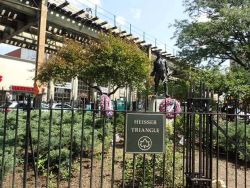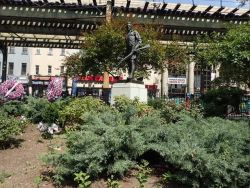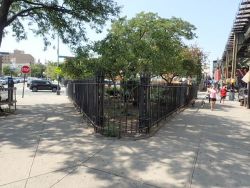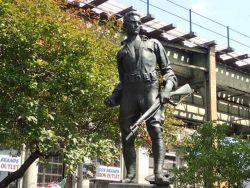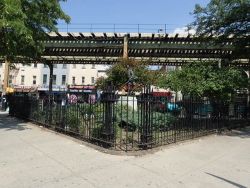Heisser Triangle
Bushwick-Ridgewood War Memorial
This dramatic bronze figure of a soldier is the work of Italian-American sculptor Pietro Montana (1890–1978). Dedicated in 1921, the monument honors the memory of the 157 servicemen from the neighboring communities of Bushwick and Ridgewood who died serving their country in World War I.
Montana was born in Alcamo, Italy, on June 29, 1890. His family moved to this country when he was a youth and settled in Brooklyn. Montana studied at the Cooper Union Art School for six years, graduating in 1915, and received additional instruction at the Mechanics Institute. In the early 1920s, Montana made a name for himself by sculpting three public monuments in Brooklyn: Freedom Square Memorial (1921), Dawn of Glory (1924) in Highland Park, and this monument in Heisser Square.
Four years after completing this statue, Montana completed a bronze tablet with relief portraits of authors Washington Irving (1783–1859) and Mark Twain (1835–1910), which today is affixed to the north wall of 11 Fifth Avenue (the Brevoort) at the south-east corner of 5 Avenue and 9th Street. Montana also created a doughboy figure for East Providence, Rhode Island, a portrait of Mother Davison for Governors Island, and a relief plaque of Catherine Carroll installed at Metropolitan Pool in Brooklyn. In the 1920s, with the help of the fraternal organization, Ordine Figli D’Italia, Montana helped form a society of Italian-American artists, which launched the Leonardo da Vinci School of Art on the Bowery.
Over the years, Montana had studios at several locations in lower Manhattan and mid-town, while residing in a three-family home he owned on Kossuth Place in Brooklyn. In his long career he received numerous public and private commissions, including a bust of the inventor Marconi for the 1939 New York World’s Fair. He was affiliated with many arts organizations, including the National Sculpture Society, the Hudson Valley Art Association, the Society of Medalists and the National Academy of Design. In 1962, when the building where he then lived at 58 West 57th Street in Manhattan was slated for demolition, Montana and his wife Alfrida Kramer returned to his native Italy, where he lived and worked until his death in 1978.
Montana was selected from a competition sponsored by the Unity Republican Club to create this statue, and the citizens of Bushwick and Ridgewood contributed $7,000 towards the commission. The architect for the granite pedestal was Giles Greene Pollard. Montana depicts an infantryman, commonly known as a “doughboy,” actively in battle, with his right fist clenched, his left hand toting a rifle, and his helmet discarded on the ground. The sculptural conception bears much resemblance to his East Providence memorial made several years later.
The sculpture was unveiled on November 20, 1921, following a parade and placement of floral wreaths around its base. The shroud was removed by daughters of the war heroes, and Municipal Court Judge Harrison Glore, chairman of the monument committee, presented the statue formally to Mayor John F. Hylan (1869–1936). The sculpture was so well received that several replicas were subsequently commissioned.
In 1937 the statue was cleaned and repatined. Having now suffered from decades of environmental corrosion, and several acts of vandalism, the monument is slated for a City funded capital renovation in 2001.
Check out your park's Vital Signs
Clean & Safe
Green & Resilient
Empowered & Engaged Users
Share your feedback or learn more about how this park is part of a
Vital Park System

